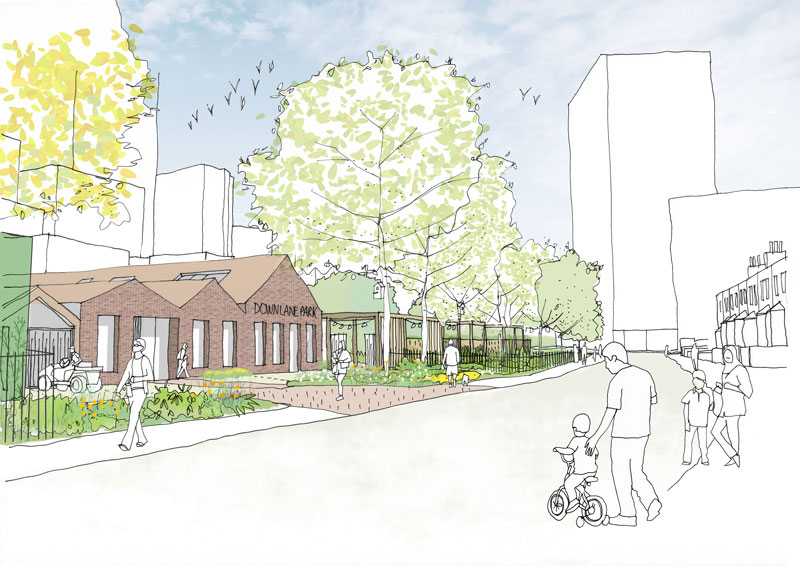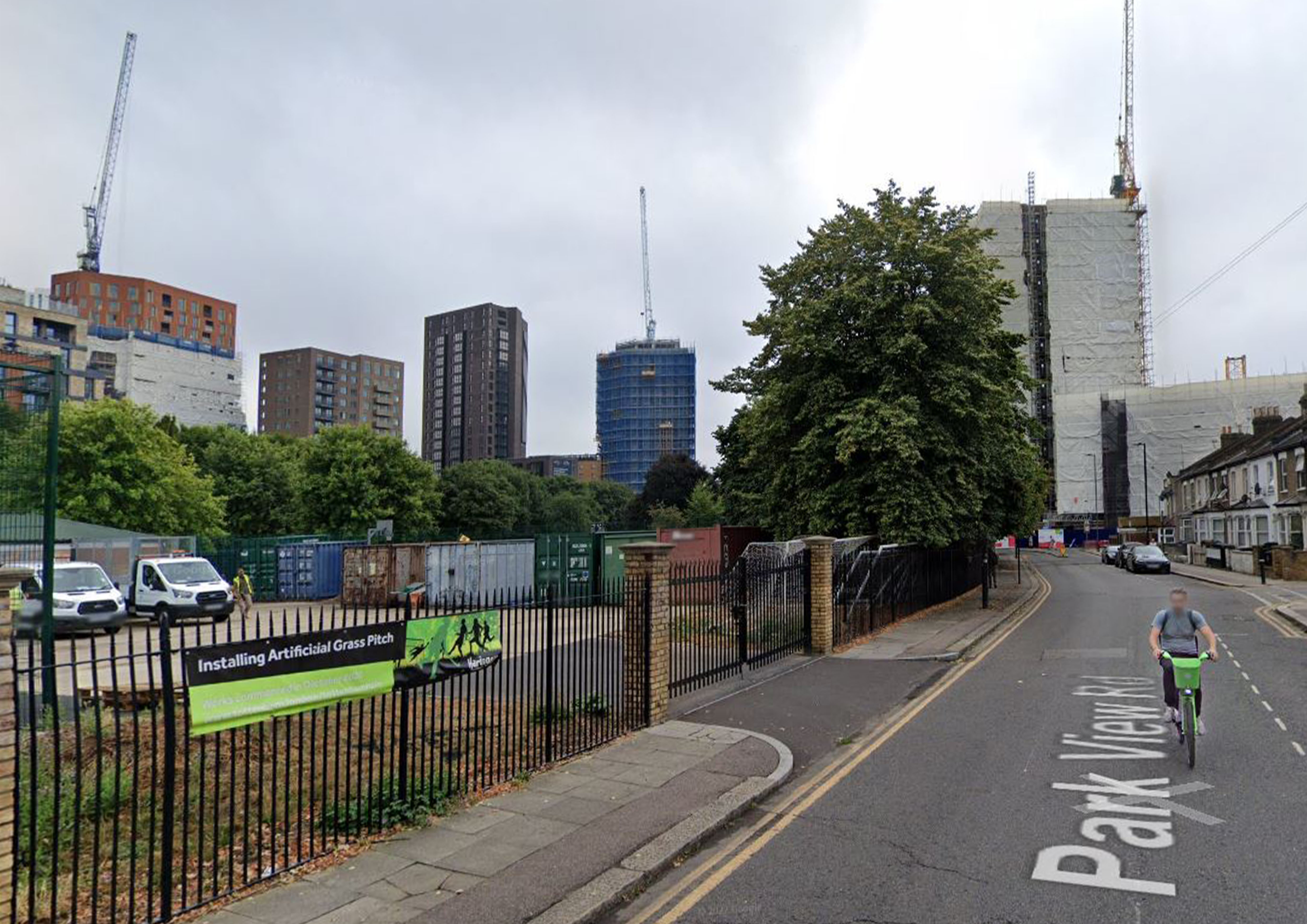Home
Have your say!
Help shape improvements to Down Lane Park.

Let us hear your views on the updated proposals for improving Down Lane Park!
Since February 2022 Haringey Council and Levitt Bernstein landscape architects have been working with a group of local residents and community representatives to co-design major improvements to Down Lane Park, N17.
The proposals for the park are rooted in what residents and park users have told us through co-design and the first round of public engagement last October and supported by the Council’s own evidence and ambitions.
Over a two-week engagement period 15-28 May we will be sharing the updated co-designed plans for the park and asking you to contribute your time, feedback and insights to help to shape the final design that will inform a planning application in the summer.
There are several ways to get involved, from in-person workshops and drop in events in the park, to filling out the survey on the next page. There are 7 questions in the survey, and it should take you roughly 10 minutes to complete.
Check out the early-stage engagement boards here.
Your feedback is really important to us and will be used to inform the refinement of the proposals and subsequent planning application.
If you do not feel confident providing feedback in English, please email jacob.sturdy@haringey.gov.uk to request a survey in an alternative language. Will we do our best to accommodate this.
1. Designing safe spaces

We have heard, particularly from young people we’ve spoken to, that improving feelings of safety is one of the highest priorities for the park. A number of people we have spoken to have told us that they would not walk through the park after dark.
We will seek to address this by improving lighting, pruning bushes and tree canopies to improve lines of sight and encouraging more activity in the park during the day and early evening, especially in quieter areas. The proposed new Community Hub building will aid this and natural surveillance.
Other priorities to improve safety in the park include better facilities and enforcement to address littering, public urination and anti-social behaviour; and measures to restrict or moderate fast moving wheeled vehicles.
We will also work with local partners and the community to encourage positive activity and stewardship of the park to discourage crime and antisocial behaviour and grow a strong community presence.
2. Community Hub, Café and Community Garden
An sketch view of the emerging designs for the community hub, viewed from Park View Road.
During our early engagement in October, feedback was divided on options to refurbish the existing Hub building or build a new one and where it should be located. Early engagement feedback indicated that residents and park users want the Hub and café to be open on more days and with longer opening hours and to include outdoor café seating and publicly accessible toilets. Many respondents wanted the café and hub to be more visible to park users and to be welcoming and truly inviting to all. You have told us that you’d like a café to be located close to the play spaces, with play spaces visible from the café and outdoor café seating areas.
Building location
The proposals we have developed following careful consideration of feedback and the needs of the community alongside a thorough pros and cons analysis, is to deliver a new community Hub, café and community garden close to Park View Road. The hub will remain close to existing sports facilities, in a location that avoids the loss of trees or green space, aids visibility and accessibility, addresses safety concerns, and supports longer opening hours.
The emerging proposals provide that the new Community Hub and café would have entrances to and from Park View Road and from inside the park. Located alongside Park View Road, the Hub is visible from most corners of the park with views across the play spaces, sports and recreational facilities, aiding natural surveillance, and making the park feel and be safer.

Building uses
Within the community hub building, a flexible community space will be provided for events, workshops and general day-today use. The café will include an outdoor seating area alongside a toddler play space.

Building form
The community hub building would be a welcoming and inclusive space for all residents, placing sustainable design at its heart. The building would have:
• Pitched roofs to provide double height rooms and therefore a generous sense of space and height inside
• Canopies connected to the building to provide shade and shelter
• An exposed timber frame internally to give a sense of warmth and a natural feeling
• Generous amounts of south-facing glazing in the community space and the café - these will look directly onto the community garden and provide natural light and views in/out of the building
• Rooflights in the community space and the café for natural top-lighting
• A timber pergola outside to provide shelter and shade for outdoor activities, particularly in extreme weather
An aerial view of the emerging designs for the community hub, café and community garden.

3. Inclusive Play Spaces
Through early engagement residents and park users indicated support for ensuring play spaces are inclusive for all. That they should serve a mix of ages, with some shaded play areas for hot summer days, particularly for younger children, and spaces to sit and socialise with other parent and carers. You told us that you supported the proposal to relocate play spaces further into the park and away from main roads.
In the latest designs three separate play spaces are located further into the park: play for toddlers; a large multi-age play area close to the Hub building and a play area further to the north for older children. There will also be less formal ‘play on the way’ dotted throughout the park. All play areas would have better shading in hot weather, exciting and inclusive play experiences, improved visibility and seating for parents and carers.
The latest plans to improve Down Lane Park would increase the size and quality of play spaces, where children of all abilities can play and have a variety of physical, sensory, and social experiences.You have told us that a variety of different play experiences would create an exciting environment for children, particularly play experiences which are adventurous, made from natural materials and unique.

4. Sports, Recreational Facilities and Spaces for Young People
 Through workshops with primary and secondary pupils, and community-led surveys, we have heard that there are few facilities to attract young people to use the park. We have heard that a grass football pitch should be retained, basketball facilities improved, and there was support for the introduction of a multi-use games court providing for a range of sports and recreational uses. We also heard that the tennis courts should be kept in their current location.
Through workshops with primary and secondary pupils, and community-led surveys, we have heard that there are few facilities to attract young people to use the park. We have heard that a grass football pitch should be retained, basketball facilities improved, and there was support for the introduction of a multi-use games court providing for a range of sports and recreational uses. We also heard that the tennis courts should be kept in their current location.
The emerging proposals respond to this feedback and seek to retain grassed football, the existing Artificial Grass Pitch and tennis courts, and introduce improved basketball and netball, lighting and stepped seating areas adjacent sports facilities that also provide spaces for young people to come together. There was also support for less traditional outdoor gym equipment and play spaces for older children, which we are seeking to incorporate. Proposals also include enhanced older children's play facilities see question 3.
We have also heard that a lack of space for changing, lack of all-weather facilities as well as charges / bookings for sports pitches can all deter young people from using these facilities.
5. Active Travel
 We have heard strong support for retaining the much-used diagonal pathway from Park View Road to Burdock Road, as well as ensuring key commuter routes are well lit and accommodate pedestrians and cyclists comfortably.
We have heard strong support for retaining the much-used diagonal pathway from Park View Road to Burdock Road, as well as ensuring key commuter routes are well lit and accommodate pedestrians and cyclists comfortably.
Park users have told us they’d like to see localised flooding addressed, pathways widened and pupils at Harris Academy in particular wanted to see a more direct route between Holcombe Road and the school, to avoid walking over muddy sections of the field during winter.
Proposals for an activity route around the edge of the park that supports walking, jogging and cycle training have been well received. Haringey Cycle Campaign and Healthy Streets North Tottenham have also asked us to consider a more direct connection through the park between Chesnut Road and a future connection to Ashley Road.
6. Landscaping, biodiversity and ecology

Through early engagement residents and park users indicated support for the proposed the approach to ecology and biodiversity, introducing additional planting of different colours, textures and scents, sustainable drainage and rainwater gardens, and creating new habitats through log piles and wildflower meadows.
There was support for the principle of removing trees, but only where this is absolutely necessary. You also asked for greater variety of trees, and that the location of new trees should improve shading in the park, such as in the children’s play spaces, whilst avoiding providing cover for anti-social activities.
There was also general support for greener and more open edges to the park, albeit respondents also expressed strong concerns around traffic on adjacent roads and safety for children and dogs; potential for increased unauthorised vehicle access; littering and fly-tipping; safety from criminal activity; and increased maintenance costs. Some respondents suggested exploring a combination of railings and hedges or planting.
The emerging designs propose a mixed approach to boundaries, retaining railings in areas where safety is a key concern, removing them where traffic volumes are low, e.g., along Ashley Road north, and introducing hedging along other sections. The designs seek to deliver a significant uplift in tree, wildflower and meadow planting, and introduce ground level changes via land forming in the northern section of the park – creating a natural grassed seating area close to the football pitch. Ecology, biodiversity and climate change resilience will be enhanced via sustainable drainage, introduction of a pond, dead-heading, log piles, and increase species diversity and complexity. The plans envisage introducing educational information boards.
This engagement phase has finished

...


